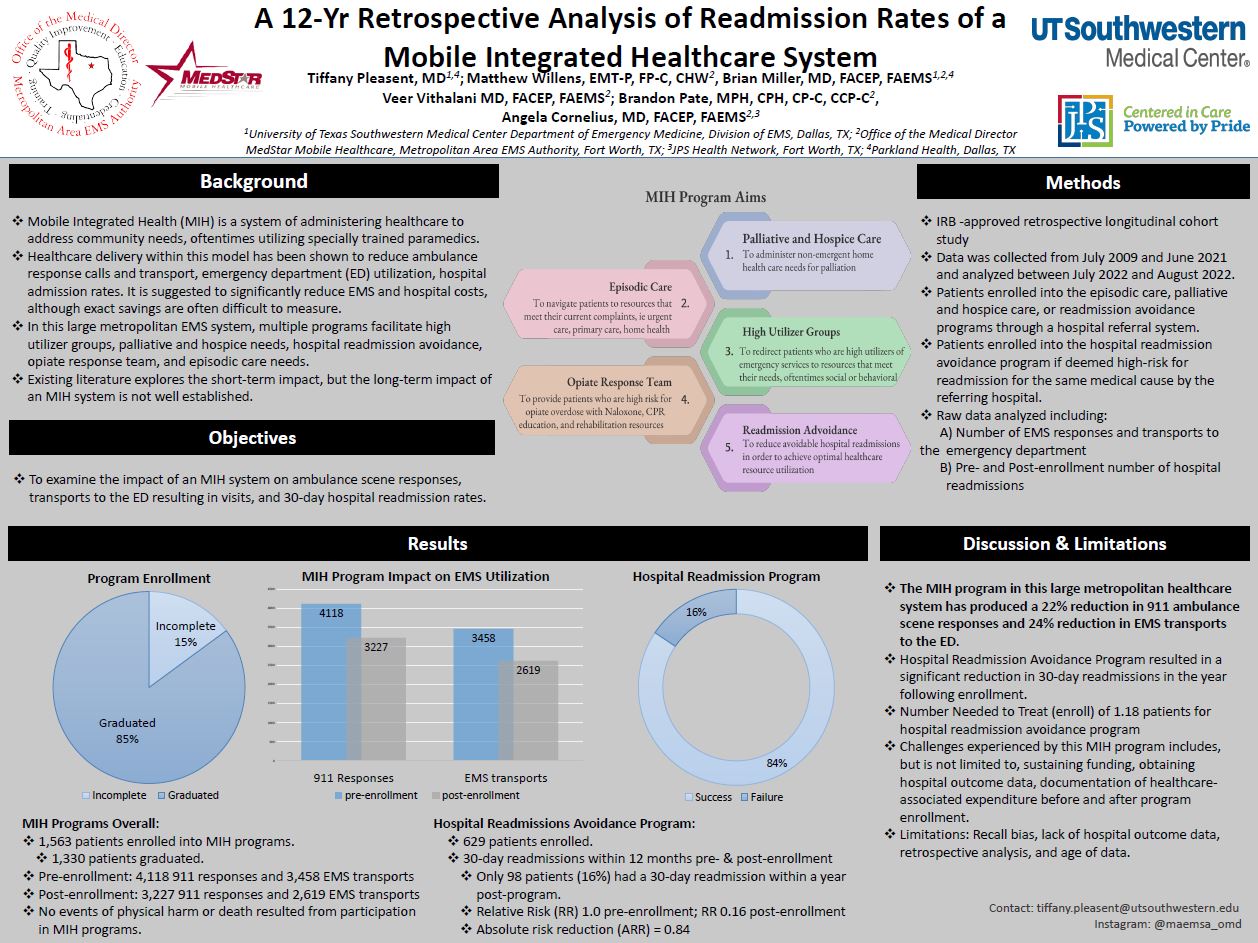EMS is healthcare, and healthcare includes medical care.
MedStar, through the Office of the Medical Director, is a primary driver in enhancing clinical care through participation in peer-reviewed and published research projects, AND internal continuous quality improvement (CQI) processes related to EMS care.
Many of these projects, both internal and external, have changed the clinical care in EMS here in Fort Worth, and across the nation.
A true demonstration of the commitment to the crucial medical component of Emergency Medical Services!
Funded research projects (Published as Part of Resuscitation Outcomes Consortium studies)
- Amiodarone, Lidocaine or Neither for Out-Of-Hospital Cardiac Arrest Due to Ventricular Fibrillation or Tachycardia (ALPS)
Synopsis: Antiarrhythmic drugs are commonly used in out-of-hospital cardiac arrest for heart arrhythmias that should respond to an electrical treatment, but without proven survival benefit. In this randomized, double-blind trial, two antiarrhythmic drugs were compared to a saline placebo. While neither drug resulted in a significantly higher rate of survival, amiodarone appeared to be more favorable. Understanding that more work needs to be done, this study provides limited guidance to prehospital protocol development.
- Pragmatic Trial of Airway Management in Out-of-Hospital Cardiac Arrest (PART)
Synopsis: PART was a multicenter cluster-crossover randomized trial to determine the effect of an initial airway management strategy for adults with out-of-hospital cardiac arrest. A strategy of initial laryngeal tube insertion was associated with significantly greater 72-hour survival compared with a strategy of initial endotracheal tube insertion. This study supported laryngeal tube placement as the initial airway management strategy for patients in cardiac arrest.
- Blood Lactate Assessment of Shock in Trauma (BLAST)
Synopsis: The blood lactate level is used to guide the management of trauma patients with severe bleeding. This observational study showed that adding blood lactate levels at the scene along with other assessment findings was predictive of immediate need for trauma resuscitation. The evidence provided supports prehospital protocol development in the resuscitation of severely injured trauma patients.
- HypoRESUS
Synopsis: The purpose of this pilot study was to determine the feasibility and safety of hypotensive resuscitation for patients with traumatic shock compared to standard resuscitation. Hypotensive resuscitation appeared to be safe and is associated with a decreased mortality rate when compared to standard resuscitation. The significance of this pilot study provides the evidence to move forward with a large-scale trial to examine its effects on survival.
- Randomized Pragmatic Prehospital Trauma Trial of Tranexamic Acid (TXA)
Synopsis: Trauma is the leading cause of death among young people mostly due to bleeding. This double-blind, randomized trial examined the impact of a medication to reduce the risk of patient with major trauma from bleeding to death. The evidence provided supports the prehospital protocol for treatment of patients with major trauma and bleeding.
Internal QA/QI projects presented as Poster and/or Oral presentations.
- Withholding of Resuscitative Efforts in Traumatic Cardiac Arrest
Synopsis: This quality improvement initiative evaluated documentation of criteria for withholding resuscitation efforts of trauma patients who were found in cardiac arrest. Through this effort education opportunities were identified and provided to the field providers.
- Non-Transport & Referral of Suspected COVID-19 EMS Patients
Synopsis: Throughout the COVID-19 pandemic, demand on EMS was greatly increased. While the majority of patients had mild symptoms, EMS was still utilized which created increased strain on the healthcare system. This quality improvement initiative drove a no-transport and referral process for stable and low-risk patients to receive help from non-hospital resources. This allowed for hospitals to assist the most critical patients.
- Validation of Proposed Criteria for Withholding Resuscitative Efforts in Out-of-Hospital Cardiac Arrest
Synopsis: This validation project supports consideration of withholding resuscitation efforts in a select population of unwitnessed out-of-hospital cardiac arrest patients that are found down and have no cardiac activity.
- Sudden Ambulance Death Syndrome: Movement of Unstable Prehospital Patients
Synopsis: The purpose of this quality improvement initiative was to look for clinical patterns in a case series where critically ill patients deteriorated quickly either in the back of, or on the way to, the ambulance. This clinical research showed that moving unstable patients resulted in sudden decompensation and that SADS is a predictable and preventable occurrence. The outcome resulted in protocol enhancements to address the unstable patient prior to patient movement to the ambulance.
- Implementation of a Standardized Worksheet Tool for the Evaluation of Patients Activating 911 for Lift Assistance
Synopsis: First Responders and EMS are frequently dispatched to assist citizens from the ground to a more mobile position. This quality improvement initiative looked to evaluate the use of a checklist to identify individuals who may be requesting lift assistance, however, may need further medical care and should be classified as patients with transport to a hospital for further evaluation. The outcome resulted in the adoption and system implementation of a Lift Assist worksheet.
- Relief of Nausea from Isopropyl Alcohol Compared to Ondansetron in the Prehospital Setting
Synopsis: Nausea and vomiting are common complaints in the prehospital setting. This quality improvement initiative was to look at the effectiveness of isopropyl alcohol compared to modern medicinal treatments for nausea. The outcome showed that inhaled isopropyl alcohol is an effective, less invasive, treatment for nausea which is easily initiated with minimal training and operational cost giving providers an alternative treatment for nausea.
- Optimizing Care for Patients Experiencing Homelessness: Reducing EMS and ED Overutilization through In-Place Treatment and Alternative Pathways
Synopsis: This quality improvement initiative looked at ways by which to optimize care for patients experiencing homelessness. A common issue in EMS systems is the use of 9-1-1 for low-acuity conditions. To better serve the patient, a treat-in-place or alternative pathway to care would provide a better option to traditional ambulance transport to an emergency room. The outcome showed that most complaints of low acuity could be treated without transport to an emergency room and prehospital programs have been developed to assist in this endeavor.
- Unrecognized Failed Airway Management Using a Blind-Insertion Supraglottic Device
Synopsis: The results of this quality improvement initiative were published in Resuscitation and has been widely referenced in many other publications on airway management. 911 Emergency Medical Services (EMS) systems utilize supraglottic devices for either primary advanced airway management, or for airway rescue following failed attempts at direct laryngoscopy endotracheal intubation. There was, however, limited data on objective confirmation of supraglottic airway placement in the prehospital environment. Furthermore, the ability of EMS field providers to recognize a misplaced airway was unknown. This quality improvement initiative showed that the use of supraglottic airway devices resulted in unrecognized failed placement resulting in the utilization of waveform capnography to prevent unrecognized misplaced airways and greater patient safety The impact of this study was felt across the entire EMS industry and drove change within EMS agencies around the world in better care of patients with supraglottic airways.
- Minimization of Unrecognized Failed Supraglottic Airways Using a Structured Quality Improvement Program
Synopsis: Supraglottic airways have been used as an alternative in many EMS Systems. The goal of this study was to demonstrate that a multifaceted quality management program generates significant improvement in clinical performance, specifically, minimization of unrecognized failed supraglottic airway placement. The interventions were able to produce a significant and persistent decrease in unrecognized failed airways and increase clinicians’ abilities to safely utilize SGAs. The results of this published improvement project have influenced the creation of quality management programs across the EMS industry, increasing patient safety.
Authored Position Statements and Evidence-Based Guidelines:
- Vithalani V, Sondheim S, Cornelius A, et al: Quality Management of Prehospital Airway Programs: An NAEMSP Position Statement and Resource Document. Prehospital Emergency Care. 2022;January 4;26(sup1):14–22.
Synopsis: This is the official position statement of the National Association of EMS Physicians, written and led by Fort Worth OMD medical directors, describing the critical role of the EMS Physician and medical director in developing and administering quality management and improvement programs overseeing prehospital airway management.
- Jarvis JL, Lyng JW, Miller BL, et al: Prehospital Drug Assisted Airway Management: An NAEMSP Position Statement and Resource Document. null. 2022;January 4;26(sup1):42–53.
Synopsis: This is the official position statement of the National Associations of EMS Physicians, written and led by Fort Worth OMD medical directors, summarizing and reviewing the existing scientific literature and identifying key factors for how drug assisted airway management should be performed for safe and effective patient care.
- Jarvis JL, et al.: Evidence-Based Guideline for Prehospital Airway Management. Prehospital Emergency Care. (2023) doi: 1080/10903127.2023.2281363
Synopsis: Lead and written by Fort Worth OMD medical director, this federally-funded national project performed a formal literature evaluation process to develop evidenced-based guidelines for prehospital airway management.

To see facts about MedStar “one of the least understood organizations in the community,”, click here: https://www.medstar911.org/category/news-and-press-releases/
To learn more about MedStar, and the EMS system, feel free to visit the Fort Worth City Manager’s EMS FAQs here: https://www.fortworthtexas.gov/departments/citymanager/med-star
To learn more about the ongoing EMS System assessment, click the City of Fort Worth news release here: https://www.fortworthtexas.gov/news/2024/2/ems-fitch-recommendations
And, a recent news from the Fort Worth Report here: https://fortworthreport.org/2024/02/20/fort-worth-is-considering-four-potential-ems-models-heres-what-theyd-do/





